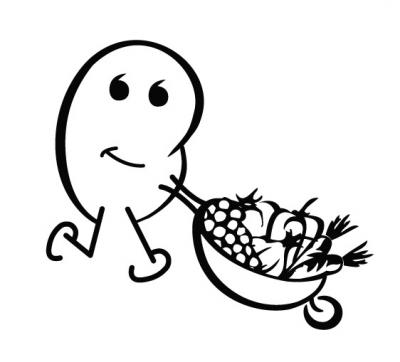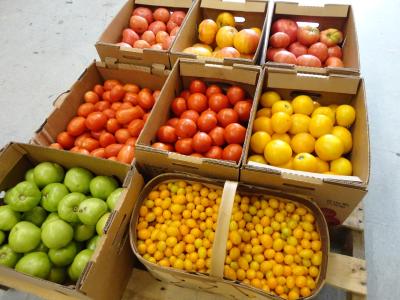 Rob M.
Rob M. | Summer Produce Storage Tips
Jul 31, 2012 at 4:57 pm |
Pickling Cucumbers: Pickling Cucumbers are a shorter, thicker skinned variety of cucumber that as the name suggests are commonly used for pickles. However, pickling cucumbers are also consumed raw as well, and tend to have significantly more flavor than the long green cucumbers most of us are accustomed to in the grocery store. Robbie Cox of Cox Farms has been growing pickling cucumbers for years, and says that they easily outsell the long green cucumbers on his farm stand. They are rarely available in the grocery store, but are commonly found in the summer direct from the farm.
Slicing Cucumbers: Slicing cucumbers, also known as long green cucumbers, are the most common type of cucumber in grocery stores. Cucumbers are best kept in the refrigerator, and should be kept as dry as possible to prevent mold. Over time cucumbers will lose moisture content, and begin to wrinkle and shrivel. You can check the freshness of a slicing cucumber by looking at the ends, which begin to wrinkle and shrivel first. Grocery store cucumbers are often coated in wax to prevent moisture loss, and extend storage life as much as possible. However, small local growers do not wax their cucumbers, they just offer a freshly picked product.
Summer Squashes: Summer squashes include a wide variety of squash like zucchini, yellow squash, patty pan squash, and eight ball squash. When selecting summer squashes, it can be a good idea to take application into consideration. For simple slicing and cooking, elongated squashes like zucchini and yellow squash are most common. Eight ball and patty pan squash can be a better choice for stuffing or topping with other ingredients. Summer squashes live close to the ground, and as such can get a little dinged up or scratched. It's important to keep summer squash relatively dry, or mold may take form in any small damaged areas of the squash. Summer squash are relatively hardy, but should be stored in the refrigerator for best results.
Bell Peppers: Bell peppers come in many varieties and colors. Most bell peppers start out green on the vine, then turn red, yellow, orange, etc. as they ripen. They can be picked early as green bell peppers, or they can be left on the vine and turn color. Since green bell peppers are picked at an earlier stage, they tend to keep longer than do colored peppers. Since colored peppers are left on the vine longer, they tend to have a sweeter more mature flavor than green bell peppers. Bell Peppers should be stored in the refrigerator, and kept dry to prevent mold growth.
Tomatoes, Slicing: Tomatoes are best stored at room temperature. Refrigerating causes them to become mealy and lose much of their flavor. Check tomatoes occasionally for softening, and use softest tomatoes first. Softness is a sign of ripeness. In good condition, tomatoes will keep for 2+ weeks, but keep an eye on any bruised or dinged spots, as these will deteriorate faster than the rest of the tomato.
Tomatoes, Heirloom: Heirloom tomatoes should be stored at room temperature, and will be at the juiciest, most flavorful if you allow them to ripen until they are very soft. Heirlooms have great flavor, and are best used fresh on burgers, sandwiches, etc. Heirlooms are very delicate, so keep an eye on any damaged or bruised spots.
Tomatoes, Roma: Like other tomatoes, romas are best kept at room temperature for juiciness and flavor. Romas are meatier and less juicy than slicing tomatoes, which makes them a good option for sauces or for cooking/baking, as you won't lose as much of them when the water weight cooks off.
Cherry & Grape Tomatoes: Grape and Cherry Tomatoes are available from early to mid June until early August. The two fruits are quite similar and often interchanged, but do have notable differences. Grape Tomatoes have recently become the more popular of the two in the United States, and production has shifted to reflect this popularity. Grape Tomatoes are generally considered the sweeter of the two, and have slightly thicker skins, which means they tend to keep a little bit longer. Cherry tomatoes have a higher water content, which essentially means they are juicier than Grape Tomatoes. Cherry Tomatoes' thinner skins and larger size also make them a better option for roasting, as they have a nice "bursting" effect when fully cooked, releasing juices and flavor to any accompanying ingredients. Cherry and Grape Tomatoes are most commonly used raw in salads, but are also delicious roasted.
Peaches: It wouldn't be summer in NC without fresh, tree ripened peaches. Peaches are extremely delicate fruits, and sometimes only keep for a few days before going bad. This is why they are best purchased locally, as out of state peaches have to be picked unripe in order to survive the rigors of shipping, which means that they have not developed full sweetness on the tree. Allow peaches to ripen on the counter, you will know they are ripe when the flesh starts to turn slightly soft, giving under light pressure. Once ripe, it is best to consume immediately, or to store them in the refrigerator. Allow refrigerated peaches to come to room temperature before eating, for optimal juice and flavor.
Corn: Corn is best eaten soon after picking, when it will be at its sweetest. Corn slowly loses sweetness after picking, as the sugars begin to convert to starch. If you cannot consume immediately, store corn in the refrigerator, unshucked. Wait until you are ready to use sweet corn before shucking, as this will increase storage life. As the corn season wears on and temperatures rise, you may see evidence of corn ear worm in NC corn. This is a pest that all local growers have to deal with, and eventually takes over entire fields of corn. The corn ear worm generally enters through the top of the corn and stays in that area, so if you find worm damage, you can usually just cut off the top 1-2 inches, and still have a full ear of corn.
4 people like this! 5.00 (2 ratings) |   (Rob M.) (Rob M.) |